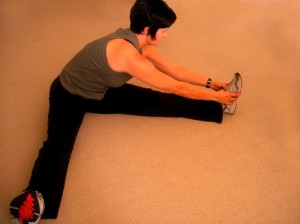When people find out that I’m a yoga teacher, they usually respond in one of two ways.
“Wow, you must be pretty flexible,”
or
“I’ve never been good at stretching. Not like my daughter/friend/etc. who is super-bendy.”
Yoga is often associated with stretching
That makes sense, because when you watch people doing yoga, you see them stretching their muscles. Or maybe you’ve taken a yoga class and felt your back muscles or hamstrings stretch when you do a forward fold.
But if yoga were just about stretching, then we’d give our yoga classes names like “The Hour of Hamstring Power” or “Brandi’s Bendy Buffet.”
At its heart, though, yoga is the ability to focus the mind on an object of your choosing. This comes straight out of the Yoga Sutras of Patañjali, basically the original how-to guide for yoga, written in the third century A.D.
So, what’s up with all the stretching, then?
 Before you can focus your mind, you have to learn how to be still. In order to do that, you have to deal with the imbalances of your body and mind. These are what I refer to as “knots,” such as old injuries, shallow breathing, a weak back, or habitual patterns of thinking.
Before you can focus your mind, you have to learn how to be still. In order to do that, you have to deal with the imbalances of your body and mind. These are what I refer to as “knots,” such as old injuries, shallow breathing, a weak back, or habitual patterns of thinking.
Yoga has many tools to help you focus your mind. Yoga poses are just one of them. We also use breathing exercises, meditation, chanting, and the way we treat others and ourselves.
As you start to work with your body, breath and mind, it becomes easier to keep your mind focused. But you will also start to open up tight areas of your body.
If focusing the mind is the yoga cake, then touching your toes is the icing. (And handstands are the chocolate ice cream to go with the cake.)
And to answer everyone’s question: no, I’m not really flexible. True, I’m much more flexible than before I started doing yoga, but I will probably always have tight hamstrings. Which is okay. I’ve talked to my hamstrings, and we’ve come to an understanding.
So don’t get fixated on being flexible. If you have a mind, you can do yoga.
__________
Photo: Veezzle


